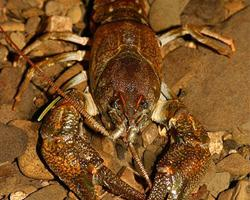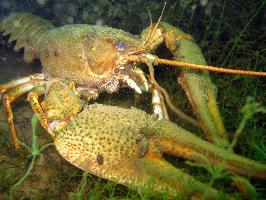
Greutăți și măsuri
| Lungime | de la 60 la 90 mm |
|---|---|
| Greutate | 100 g |
Starea de conservare
| Amenințat |
Descrierea animalului
The Stone crayfish, scientifically known as Austropotamobius torrentium, is a fascinating species of freshwater crayfish endemic to Europe. This species is particularly notable for its preference for cold, clear, and fast-flowing streams and rivers, thriving in environments that many other aquatic species might find challenging. The Stone crayfish is an important component of freshwater ecosystems, playing a critical role in nutrient cycling and serving as both predator and prey within its habitat.Morphologically, the Stone crayfish is characterized by a robust and compact body, which is well-adapted to resist the strong currents of its preferred habitats. Its exoskeleton, which provides protection against predators and environmental hazards, exhibits a range of colors from dark brown to a more muted grey or olive, allowing it to blend seamlessly with the riverbeds and stones among which it dwells. The crayfish has a pair of large, powerful pincers (chelae) which are used for defense, feeding, and manipulating its environment. Its body is segmented into two main parts: the cephalothorax, which is a fusion of the head and thorax, and the abdomen, which is flexible and aids in locomotion, particularly the tail flip movement used to escape predators swiftly.
Adult Stone crayfish typically reach lengths of up to 10 centimeters, though size can vary based on environmental conditions and availability of resources. They are omnivorous creatures, feeding on a diet that includes detritus, plant material, and small invertebrates. This diet, combined with their role as prey for fish, birds, and mammals, positions them as integral links within their ecosystem's food web.
The reproductive cycle of the Stone crayfish is an interesting aspect of its biology. Mating occurs in autumn, with females carrying the fertilized eggs attached to their swimmerets under the abdomen until they hatch in the spring. This extended parental care ensures that the offspring have a higher chance of survival in the often harsh environments they inhabit. The juveniles grow rapidly, undergoing several molts before reaching maturity.
Conservation status of the Stone crayfish is a growing concern. The species is listed as vulnerable by the IUCN, facing threats from habitat destruction, pollution, and particularly the introduction of non-native crayfish species, which can outcompete native populations or introduce diseases such as the crayfish plague (caused by the pathogen Aphanomyces astaci). Conservation efforts are underway in several countries to protect and restore habitats, as well as to implement measures to prevent the spread of invasive species and diseases.
In summary, the Stone crayfish is a remarkable species, both in terms of its ecological role and its adaptations to life in fast-flowing freshwater environments. Despite its resilience, the species faces significant threats that necessitate concerted conservation efforts to ensure its survival for future generations to marvel at and study.
Animale similare
Fotografii noi cu animale
Top 10 animale
- Dolphin gull (Leucophaeus scoresbii)
- Diana monkey (Cercopithecus diana)
- Moustached guenon (Cercopithecus cephus)
- Galápagos tortoise (Geochelone nigra complex)
- Stone loach (Barbatula barbatula)
- Japanese macaque (Macaca fuscata)
- Greek tortoise (Testudo graeca)
- Russian tortoise (Testudo horsfieldii)
- Common flying dragon (Draco volans)
- Galápagos penguin (Spheniscus mendiculus)


